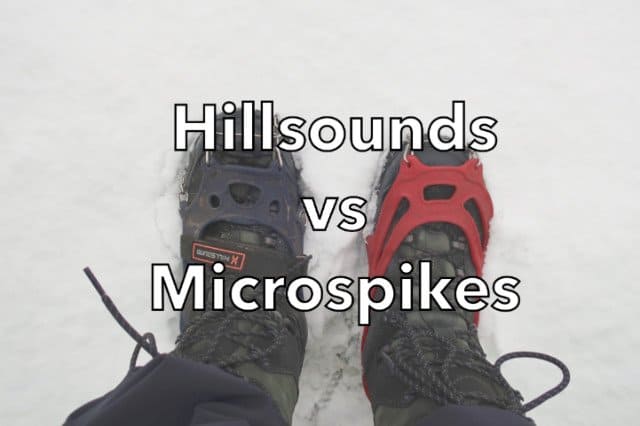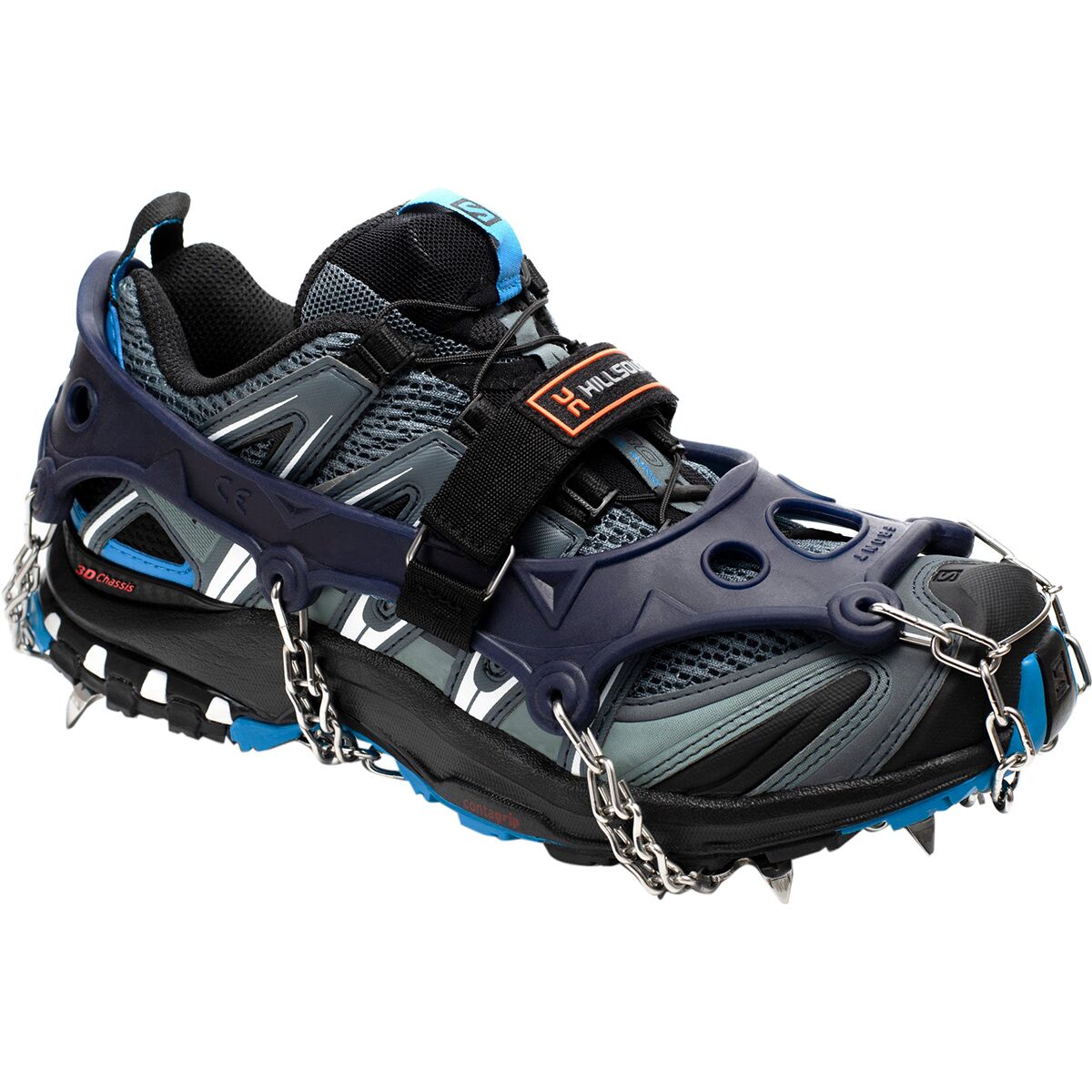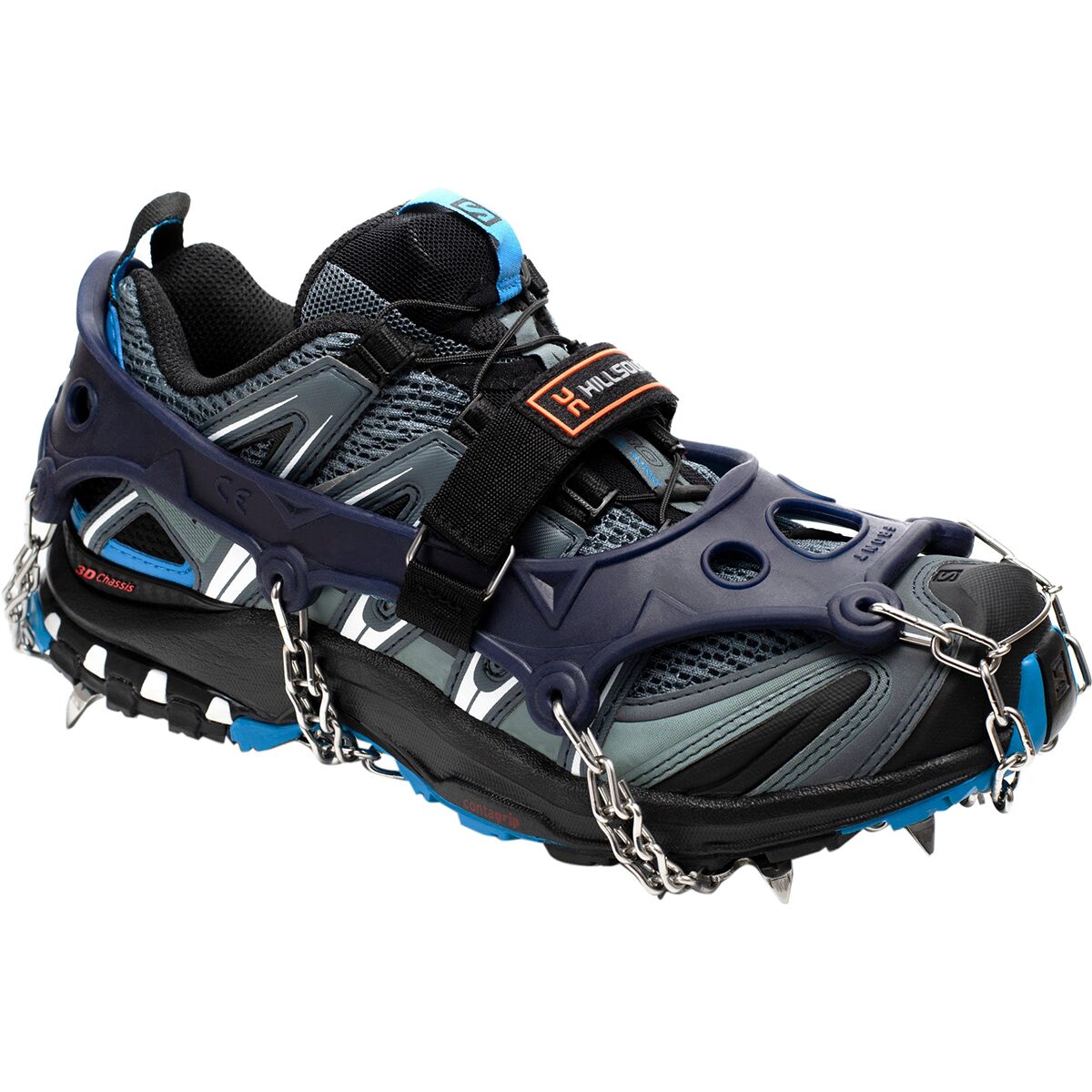
Hillsound Trail Crampon Ultras and Kahtoola Microspikes are the most popular winter traction aids for hiking on packed snow, ice, and mixed ice and rock. They’re like tire chains for your feet, with tiny metal spikes and chains that are attached to an elastic harness that you slip over your boots or shoes. When they first came out, about 10 years ago, they revolutionized winter hiking because they worked with all kinds of shoes, from trail runners and hiking boots to Pac boots and mountaineering boots, and were much lighter weight than the steel mountaineering-style crampons and in-step crampons that they replaced.

Spec Comparison
- Hillsound Trail Crampon Ultra:
- Binding: Stretchy Elastomer
- Number of Spikes: 18
- Spike Length
- Front: 1/2″
- Rear: 2/3″
- Weight: 14.5 oz (size medium)
- Footwear size compatibility: (Note: Different sizing is required for trail runners, hiking boots, and pac boots)
- Men’s: 5-15
- Women’s: 6-13
- Kahtoola Microspikes
- Binding: Stretchy Elastomer
- Number of Spikes; 12
- Spike length: 3/8″
- Weight per pair: 11 oz to 13.5 oz
- Footwear size compatibility: (Note: Different sizing is required for trail runners, hiking boots, and pac boots)
- Men’s: 5-16
- Women’s: 6-12
Kahtoola Microspikes were first to market and were widely adopted by winter hikers when they first came out. Hillsound subsequently brought out a product called Trail Crampon Ultras, which are very similar to Kahtoola Microspikes but have more spikes and longer spikes attached to their chains. The spikes on the Hillsounds are longer under the heel, which is highly advantageous to prevent sliding or falling when you’re walking down an icy slope, since you’re likely planting your heel first with most of your body weight behind it. In addition, the Hillsound’s spikes are longer which means you’ll get deeper penetration and therefore better traction on snow, ice, or slush.
The Hillsound Trail Crampon Ultras also come with a velcro top strap that holds them onto your boots so you can’t lose them if they pop off and you don’t notice it. I’ve had this happen to me more than once when I used Kahtoola Microspikes and it’s a costly replacement. There’s nothing stopping you from adding a velcro strap of your own to the Kahtoola’s, but it’s a head-scratcher as to why they’ve never bothered to add such a useful feature to the Microspikes or to improve on the basic model in any way.

In all other respects, most notably the Elastomer bindings, the Hillsounds and Microspikes are virtually identical. They have nearly the same range in terms of footwear size compatibility and harness durability. The sharpness of the stainless steel spikes will wear down after several years of hard use, and while you can try to sharpen them with a file, they’re affordable enough that you can just buy a new pair and use the old ones for your commute.
If your winter hikes include steep terrain and mountains, I’d definitely recommend the Hillsound Trail Ultras over the Kahtoola Microspikes because they provide better traction with more spikes (points of contact) and longer spikes for deeper penetration and traction. That said, I spent years hiking in the same terrain with Kahtoola Microspikes without having any bad experiences using them, other than the fact that they pop off sometimes. If you can only find Microspikes and you need a pair right away, I’d go ahead and buy them. But my preference is for the Hillsound Trail Ultras, which I still use to this day.
Compare 2 Prices
-

 Backcountry.com
Backcountry.com$79.00$59.25View -

 Backcountry.com
Backcountry.com$79.00$59.25View -

 Amazon US$87.00View
Amazon US$87.00ViewAmazon.com Price: $87.00 (as of 04/20/2024 11:22 GMT-0400) Details
Product prices and availability are accurate as of the date/time indicated and are subject to change. Any price and availability information displayed on Amazon.com at the time of purchase will apply to the purchase of this product.
 SectionHiker.com Backpacking Gear Reviews and FAQs
SectionHiker.com Backpacking Gear Reviews and FAQs
I use to use the Kahtoola’s, but switched to the Hillsounds on the PCT this summer.
The Hillsounds were a HUGE improvement over the Kahtoolas in soft mushy snow.
On early morning ice, I’d say they’re about equal.
I use the LL Bean house-brand traction devices which feature a “boa” closure. These are stainless steel wire/cables on a ratchet device which keeps them secure and makes them easy to put on and take off while wearing gloves. I usually don’t wear traction devices all day — just putting them on when needed — so easy use is important. Since the boa closure makes them adjustable, I can use them for a variety of shoes and boots. They are a little heavier and more expensive than Hillsounds, but the added function is worth it to me.
Tanks, Mark. I’ve been wondering how the LLBean version stacks up to the more popular brands. I’m in the market because after years use, My Kahtoola microspikes have stretched out and keep falling off on the trail.
We have been using Hillsounds for years, second that they are better all the way around. We have never had any issues.
The Hillshounds seem to be superior to the Kahtoolas in every respect now, especially since Kahtoola made the elastomer rand lighter (i.e. cheaper) a few years ago.
As for sharpening a used pair, a Dremel moto tool with a grinding stone works well. Just don’t let the metal get so hot it loses its temper.
Kahtools come in. Longer length tooth size as well
Completely different products.
The original Hillsound Trail Crampons with the two spike plates are still the best.
I’ve used the Hillsound Trail Crampon (non-Ultra) for several years. I’ve noticed they absolutely have better traction than the Kahtoola’s, especially after some use. The carbon steel is harder, longer, more pointed and does not wear as quickly in my experience. The down side to the steel is, while it is coated, I have had some rust develop if left in a wet condition for too long. Not a big deal if you keep them dry. These also use a 2/3″ spike all around. Looks like the Ultras went with a stainless steel spike, so a moot point if you opt for those.
I have Snowline Chainsen Pro. Less expensive and work well.
I have Hillsound Freesteps6 and love them. But your comparison isn’t fair, nor helpful as a comparison, because you should be comparing those Kahtoola’s to the Freesteps6 and not the Ultra’s as they are like apples and oranges. I am going to order the Ultra’s to have for serious conditions that would be a step below needing full on Ice Crampons. They look like a great product and thanks for testing them.
Three of us just hiked up Moosilauke – 2 of us had microspikes and the other had Hillsounds. The snow was sticky. We had to stop constantly for our friend to clear the Hillsounds. She was essentially walking on 1970s platform shoes with the 2-4″ snow accumulation on the Hillsounds. The 2 of us on microspikes were not having any issues with snow accumulation. Our only explanation, without making a major study of it, was that the spikes on the Hillsounds are a tiny bit longer but enough to grab and hold on to the snow. Weight and size was not a factor as I am the same size/weight so that comparison is the same between the 2 systems.
This is totally dependent on snow conditions. I’ve had snow ball under my kahtoola’s the size of bowling balls. Same with Hillsounds. When this happenes, just take them off.
Unfortunate that you didn’t swap with each other to see if size/weight/walking style made any difference.
Interesting. I would guess its a function primarily of the surface area of the metal in contact with the snow.
Great review! Is there a difference between the Hillsound Trail Crampons Ultra and the Hillsound Trail Crampons – not Ultra that are sold at REI? Thanks.
This goes into a lot of detail.
https://sectionhiker.com/which-hillsound-trail-crampon-is-right-for-you-how-to-choose/
Wow, that was quick! I guess I didn’t delve deep enough into your gear reviews. I think I like the additional spikes on the Ultra model for a little more traction on slopes. For $3 extra it seems worth the expense.
Another detail that I didn’t see in your excellent review is that the Ultra model has stainless steel spikes and the non-Ultra model has carbon steel spikes. According to the review on Amazon some people commented that the carbon steel can rust and the stainless won’t.
BTW, Dexter Robinson recommended your website.
Thanks again.
Anybody simply add Goat Head sole spikes or similar hobnails for traction to their boots without the need to put on and take off the microspikes?
Ever tried walking on bare rock with those? Very slippery on an angled surface. Also, wifey gets pissed when I wear them on the hardwood floors. I prefer the portability of microspikes over certain death!
Which is better really depends on the trail condition. I hike a lot in the mountains of New Hampshire where the surface is mostly boulders and exposed bedrock. If there is a good uniform cover of snow, more than a few inches, then longer spikes of the Hillsound are superior. But as is so often the case whether on Monadnock in southern New Hampshire and less than 4,000 feet or in the White Mountains further north and at higher elevations the surface is “bony” with much of the snow blown off exposing the underlying rock surface often coated with ice. In this case the shorter spikes of the Katoolas are far easier to walk on and frankly more stable under foot. I have both and often carry both and use whichever the trail conditions call for. If I had to pick one given the conditions I most often encounter I find the katoolas are more versatile. Adequate over packed snow and more stable on exposed rock and on sheets of ice. For deeper snow I use mountaineering snow shoes or real crampons.